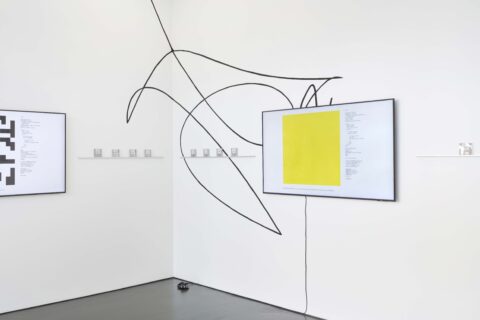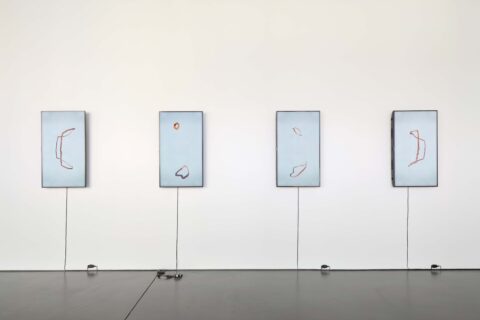Rhea Myers The Fractionalized Phallus
07/03/2025 – 17/04/2025
Galerie Nagel Draxler
Weydingerstr. 2/4
10178 Berlin
Opening / Eröffnung:
Freitag, 7. März 2025, 17 – 20 Uhr
Friday, March 7, 2025, 5 – 8 pm
Öffnungszeiten / Opening hours:
Dienstag - Freitag 11 – 18 Uhr, Samstag 12 – 18 Uhr
Tuesday - Friday 11am – 6pm, Saturday 12 – 6pm
The gallery will be closed on March 8th for International Women's Day.
Press Release
*Please scroll down for the German version.*
Rhea Myers' exhibition features new works that repurpose blockchain technologies and cryptographic concepts to explore themes of identity, ownership, and self-determination. From NFTs that challenge traditional notions of gender and personhood to generative art inspired by cypherpunk ideals, the exhibition interrogates societal power structures and the anxieties they produce.
Following The Ego, And It’s 0wned, The Fractionalized Phallus deepens the transfeminine perspective in Rhea Myers’ work and transforms the artist’s own body into a fragmented relic of a past self. 3D scans, no longer tied to the body they once represented, collapse the patriarchal master signifier into the marketplace, where it is redistributed, deconstructed, and rendered mutable. This dissolution of fixed identity finds a parallel in Self-Identifying, where generative PostScript programs create unique images embedded with their own cryptographic identity. Here, the artwork does not just depict identity but enacts it, asserting autonomy in both form and function and interrogating authorship. The critique of systemic control takes another form in Non, where the legal frameworks that govern corporate power become the subject of the work itself. Through an NFT embedded with Non-Disclosure and Non-Disparagement clauses, the piece reflects on the entanglement of labor, ownership, and compliance, exposing the anxieties and mispriced fears of late startup culture. In doing so, Non reads like marriage vows: love, honor, and obey.
Rhea Myers is an artist, hacker, and writer based in British Columbia, Canada, originally from the UK. Since 2014, she has used the blockchain as a medium for embodying, critiquing, and moving beyond the anxieties of post-financial-crisis society. Her work places technology and culture in mutual interrogation to produce new ways of seeing the world as it unfolds around us. Myer‘s art has gained international recognition with exhibitions at Buffalo AKG Art Museum, New York (USA), HEK, Basel (CH), ArtScience Museum, Singapore (SGP), Kunsthalle Zürich (CH), Francisco Carolinum, Linz (CH) and Schinkel Pavillon, Berlin (GER).
The anthology Proof Of Work. Blockchain Provocations 2011–2021 reflects on her pioneering projects and understanding of conceptual art and decentralized technology.
___
Against Disruption: Trans Hackers in the Age of Blockchain
Maria Babusch
"She manipulates the epics, rearranges the poems of the powerful, snips away at their documents until something new emerges." This was how I attempted to characterize the figure of the hacker in my piece Hackers on Estradiol, which adopts a historical perspective. My depiction was inspired by the Hacker Manifesto of theorist McKenzie Wark. More than twenty years after the publication of this classic of media philosophy, twenty-five years after the release of the first Matrix film, and over a decade after the so-called Transgender Tipping Point, it is fair to say that the figure of the trans hacker has gained a certain degree of establishment. Yet, even as she still carries an aura of subversion, she is simultaneously threatened by assimilation into a tech industry that is increasingly turning hacking into a fundamental method of power and capital accumulation. The hacker originates from a different era of the internet. Her forms of resistance are becoming ever more difficult to practice.
Californian Thinking
For the artist Rhea Myers, the essay The Californian Ideology (1995) also held a kind of manifesto-like significance. Indeed, its authors, Richard Barbrook and Andy Cameron, were among the first to confront the information technology industry of the infamous Silicon Valley using the tools of Critical Theory. Building on their work, we are now able to historically trace our present information age.
One possible starting point for this history could be a courthouse in Philadelphia, where, in 1983, the company Apple first succeeded in extending intellectual copyright to binary code. As a result, this "information" was no longer free, allowing its value to be extracted. The initial public offering of Apple Computer, Inc. had taken place less than three years before this court ruling.
Asymmetric Data
It always comes down to datasets. Datasets are read. They are produced and manipulated. Processed and transmitted. Around this domain, an entire political economy has formed, placing new technologies at its service. The blockchain is just one of many innovations burdened with the grand promise of changing the world and liberating humanity. Boundless techno-optimism was already identified by Barbrook and Cameron as a defining feature of the Californian Ideology. But if one takes a step back from this belief in progress, numerous questions arise. What exactly is the world-changing potential of blockchain, for example? What kind of information is at stake here, and what do these pieces of information actually tell us?
The mechanics of cryptography are easy to look up—after all, we live in an age of informational abundance. And yet, this does not mean we truly understand what is at play. A certain need for explanation is, in fact, an inherent feature of new technologies. When they are presented in terms of their potential for the future, it often remains unclear what this potential actually consists of. Instead, it functions primarily as a kind of historical-philosophical affect: the sense that we lack the relevant information, that we do not know what is at stake—that is what it is about. Rhea Myers' work embraces precisely this ambiguity.
The Ideology of Disruption
The trans hacker is one who operates in secrecy, discovering loopholes within the order of power while simultaneously manifesting this ethos through her bodily subjectivity. Both her actions and her gender are shrouded in a nylon veil of danger and illegality. This only makes her more alluring; the hacker’s program is disruption—she opens doors to new worlds.
One might therefore assume that, within information capitalism, the trans hacker would enjoy a certain popularity—after all, “disruption,” the production of difference, is precisely the method by which value is generated in this system. Silicon Valley successfully appropriates this disruption as a narrative, positioning itself in the tradition of counterculture—rebellious, nonconformist, and anti-authoritarian—while fusing this story with boundless techno-optimism. This makes it attractive to financial markets. More than anything else, new technologies are highly desirable investment objects.
Of course, the trans hacker herself remains excluded from such possibilities of accumulation. And yet, the aura of disruption still clings to her, as it does to trans women more broadly. Only now, disruption has turned into a stigma. In times of trans panic, she no longer opens up unforeseen possibilities; instead, she is cast as a threat to the social order, a sexual aggressor. The tech industry—and its stock prices—can comfortably coexist with this narrative. As long as sexual minorities are framed as the cause of social tensions, suspicion does not fall on them.
The Hacking of Gender Identities
Nowhere is the formation of a transmisogynistic society through new technologies more visible today than in the United States, where the state itself becomes a hacker of gender identities. Tools of targeted exclusion from public life include government techniques such as advanced facial recognition software, which, when combined with the laws of the new administration, promise maximum efficiency.
If, for instance, entry into the U.S. were to be criminalized for trans people, this would serve a dual purpose: First, it would provoke legal transgression, since everyone understands that one can still enter the country—provided one is able to pass. This, in turn, legitimizes further state persecution. At the same time, it mobilizes both law enforcement and civil society to refine their cultural techniques of transvestigation—methods of scrutinizing and identifying trans people—thus accumulating more information, and with it, power, over transfeminine individuals in particular.
Digital Aesthetics of Production
The situation is precarious—we see this in the fact that we do not know what is at stake. But if what is at stake is precisely that we do not know what is at stake, then what, in turn, does this mean for art?
The work of Rhea Myers can help us think through these questions. Of one of her pieces, she once said: “It tells you everything except for the one thing that you want to know, which is what the content actually is. That was 2018. And then in 2021, I suddenly realized that this might be about me, about there being something that was hidden very effectively in my lifetime of experience.” The years here mark the time before and after the beginning of her transition. This reveals something crucial: by forming artistic connections with technology, its supposed infinite potentiality can, in fact, be realized subjectively. In art, information always refers to something other—and sometimes, that other is transness itself.
At the same time, Myers distances herself from the dominant narrative of disruption and boundless potential when, in an interview, she soberly describes blockchain as “a chance for social reform.” In the end, perhaps it is not so much about what kind of aesthetics the information age produces, nor about how fundamentally different these might be from anything that came before. Perhaps the question of new technologies today is, above all, a question of the conditions under which art is produced. Myers calls herself the first Bitcoin artist—by which she means the first artist to be paid in Bitcoin. Whether art is ultimately subjugated by technology, or whether it manages, with the help of blockchain, for instance, to carve out a degree of autonomy—enabling at least a few artists to make a living—is both a political and legal question. Myers addresses this by adopting a queer political slogan: “Trans Rights Are Human Rights.” It is about human rights, not property rights.
______
Rhea Myers’ Ausstellung zeigt neue Werke, die Blockchain-Technologie und kryptografische Konzepte nutzen, um Themen von Identität, Besitz und Selbstbestimmung zu erforschen. Von NFTs, die traditionelle Vorstellungen von Geschlecht und Person-sein hinterfragen, bis hin zu generativer Kunst, die von Cypherpunk-Idealen inspiriert ist, setzt sich diese Ausstellung kritisch mit gesellschaftlichen Machtstrukturen und den Ängsten auseinander, die sie hervorbringen.
Im Anschluss an The Ego, And It’s 0wned vertieft The Fractionalized Phallus die transfeminine Perspektive in Rhea Myers’ Werk und macht den eigenen Körper der Künstlerin zum fragmentierten Überbleibsel eines vergangenen Selbst. Die 3D-Scans, losgelöst von der physischen Realität, die sie einst abbildeten, zerlegen das patriarchale Hauptsignifikat und werfen es auf den Markt, wo es zerfällt, verteilt und zur Ware wird. Diese Auflösung fester Identitäten findet eine Parallele in Self-Identifying, wo generative PostScript-Programme einzigartige Bilder erschaffen, die mit ihrer eigenen kryptografischen Identität versehen sind. Hier stellt das Kunstwerk nicht nur Identität dar, sondern vollzieht sie – es behauptet Autonomie sowohl in Form als auch Funktion und hinterfragt Autorschaft. Die Kritik an systemischer Kontrolle setzt sich auch in Non fort, indem die rechtlichen Rahmenbedingungen von Unternehmensmacht selbst zum Gegenstand des Werks werden. Ein NFT, das an Geheimhaltungs- und Nichtverleumdungsklauseln geknüpft ist, spiegelt die Mechanismen der Unternehmenswelt wider, reflektiert die Verflechtung von Arbeit, Besitz und Unterwerfung und offenbart die Ängste und Selbsttäuschungen der späten Startup-Kultur. Non liest sich wie Ehegelübde: lieben, ehren und gehorchen.
Rhea Myers ist eine Künstlerin, Hackerin und Schriftstellerin aus dem Vereinigten Königreich. Sie lebt und arbeitet in British Columbia, Kanada. Seit 2014 nutzt sie die Blockchain als Medium, um die Ängste der Gesellschaft nach der Finanzkrise aufzuzeigen, zu kritisieren und zu überwinden. Ihr Werk stellt Technologie und Kultur in eine wechselseitige Befragung, um neue Perspektiven auf die Welt zu schaffen, während sie sich um uns entfaltet. Myers' Kunst hat internationale Anerkennung gefunden und wurde unter anderem im AKG Buffalo Museum, New York (USA), im HeK, Basel (CH), im Art Science Museum, Singapur (SGP), in der Kunsthalle Zürich (CH), im Franzisco Carolinum, Linz (AT) und im Schinkel Pavillon, Berlin (DE) ausgestellt, sowie in renommierten Auktionshäusern wie Sotheby’s und Christie's verkauft. Die Anthologie Proof of Work. Blockchain Provocations 2011–2021 reflektiert ihre wegweisenden Projekte und ihr Verständnis von Konzeptkunst und dezentraler Technologie.
___
Gegen die Disruption. Trans Hacker im Zeitalter der Blockchain.
Maria Babusch
„Sie manipuliert die Epen, vertauscht die Poeme der Mächtigen, schnippelt so lange an ihren Unterlagen herum, bis daraus etwas Neues entsteht.“ So habe ich, in meinem als historisch zu betrachtenden Stück Hacker auf Estradiol, die Figur der Hackerin zu charakterisieren versucht. Angelehnt war meine Typisierung an das Hacker Manifesto der Theoretikerin McKenzie Wark. Über Zwanzig Jahre nach Erscheinen dieses Klassikers der Medienphilosophie, 25 Jahre nach dem ersten Matrix Film und über Zehn Jahre nach dem sogenannten Transgender Tipping Point lasst sich sagen, dass die Figur der Trans Hackerin eine gewisse Etablierung erfahren hat. Aber auch wenn sie noch heute die Aura der Subversion umgibt, ist sie gleichzeitig bedroht von der Subsumierung durch eine Tech-Industrie, die sich anschickt, das Hacken zur prinzipiellen Methode der Macht- und Kapitalakkumulation zu machen. Die Hackerin stammt aus einer anderen Ära des Internets. Ihre Formen des Widerstands werden zunehmend schwer zu praktizieren.
Kalifornisches Denken
Für die Arbeit der Künstlerin Rhea Myers besaß auch der Aufsatz „The Californian Ideology“ (1995) eine Art Manifestcharakter. Tatsachlich gehörten dessen Autoren Richard Barbrook und Andy Cameron zu den Ersten, die der Industrie der Informationstechnologien aus dem berühmt berüchtigten Silicon Valley mit den Mitteln der Kritischen Theorie begegneten. Auf ihrer Arbeit aufbauend sind wir heute in der Lage, unser gegenwartiges Informationszeitalter historisch nachzuvollziehen. Beginnen könnte diese Geschichte etwa mit einem Gerichtshaus in Philadelphia, in dem es der Firma Apple 1983 erstmals gelang, das Geistige Urheberrecht auf einen Binaren Code auszuweiten. Diese „Information“ war in der Folge nicht mehr frei und so konnte ihr Wert abgeschöpft werden. Der Börsengang von Apple Computer, inc. war keine drei Jahre vor dem Gerichtsurteil erfolgt.
Asymmetrische Daten
Immer geht es um Datensatze. Datensatze werden gelesen. Sie werden produziert und manipuliert. Prozessiert und Übertragen. Um diesen Bereich herum bildet sich eine ganze Politische Ökonomie heraus, in dessen Dienst die Neuen Technologien gestellt werden. Die Blockchain ist nur eine von vielen Neuerungen, an die nicht weniger als das Versprechen geheftet ist, dass sie die Welt verandern und den Menschen befreien werden. Der grenzenlose Techno-Optimismus wurde bereits von Barbrook und Cameron als das Merkmal der Kalifornischen Ideologie herausgearbeitet. Doch tritt man einen Schritt vor diesem Fortschrittsglauben zurück, stellen sich schnell zahlreiche Fragen. Worin genau besteht denn nun das weltverändernde Potential etwa der Blockchain? Um welche Informationen geht es hier und was sagen uns diese Informationen?
Die Funktionsweisen der Cryptographie lassen sich einfach recherchieren, schließlich leben wir ja im Überfluss der Informationen. Aber dadurch versteht man immer noch nicht wirklich, worum es hier geht. Eine gewisse Erklärungsbedürftigkeit ist tatsachlich inhärenter Bestandteil der Neuen Technologien. Wenn Neue Technologien in ihrer Potentialität für die Zukunft präsentiert werden, bleibt meist unklar, worin dieses Potential besteht. Es funktioniert vor allem als geschichtsphilosophischer Affekt. Dass wir die relevanten Informationen eben nicht besitzen; dass wir nicht wissen, worum es geht - darum geht es. Die Arbeiten Rhea Myers' machen sich dies zu Eigen.
Ideologie der Disruption
Die Trans Hackerin ist eine, die, im Verborgenen agierend, Schlupflöcher in der Ordnung der Macht findet und diesen Ethos gleichzeitig durch ihre Körperlichkeit als Subjekt manifestiert. Dabei sind sowohl ihre Tatigkeit als auch ihr Geschlecht in einen Nylonschleier der Gefahr und der Illegalität gehüllt. Dieser Umstand macht sie nur attraktiver; das Programm der Hackerin ist Disruption, sie öffnet die Türen zu neuen Welten. Es ließe sich also im Informationskapitalismus durchaus eine Beliebtheit der Trans Hackerin vermuten, ist hier doch „Disruption“, die Produktion von Differenz, genau die Methode, mit der in ihm Mehrwert geschaffen wird. Dadurch das es dem Silicon Valley gelingt, sich diese Disruption narrativ anzueignen; sich in der Tradition der Gegenkultur als rebellisch, nonkonformistisch und antiautoritär zu erzählen und diese Erzählung mit einem uferlosen Techno-Optimismus zu verbinden, wird es attraktiv für die Finanzmarkte. Die Neuen Technologien sind vor allem dies: Beliebte Investitionsobjekte.
Von solchen Möglichkeiten der Akkumulation ist die Trans Hackerin natürlich nicht betroffen. Aber auch ihr, und der transsexuellen Frau überhaupt, haftet noch immer die Aura der Disruption an. Nur das diese jetzt ein Stigma geworden ist. In Zeiten der trans panic eröffnet sie nicht langer ungeahnte Möglichkeiten, sondern bedroht die Soziale Ordnung als Sexueller Aggressor. Die Tech-Industrie und ihre Aktienkurse können mit dieser Erzählung gut leben. Solange Sexuelle Minderheiten als Ursache Gesellschaftlicher Spannungen betrachtet werden, fallt der Verdacht nicht auf sie.
In den USA lasst sich heute so gut wie sonst nirgends betrachten, wie die transmisogyne Gesellschaft in Ausbildung mit der Hilfe Neuer Technologien selbst zum Hacker der Geschlechtsidentitäten wird. Zur gezielten Ausgrenzung aus dem öffentlichen Leben stehen Regierungstechniken wie intelligente Gesichtserkennungssoftware zu Verfügung, die in Verbindung mit den Gesetzen der neuen Administration höchste Effektivität aufweisen dürften.
Wenn nun zum Beispiel die Einreise in die USA für trans Personen illegalisiert wird, erfüllt dies einen doppelten Zweck: Es provoziert den Gesetzesbruch, da jedem klar ist, dass man sehr wohl einreisen kann, wenn man es nur schafft zu passen; wodurch dann weitere Verfolgung durch den Staat legitimiert wird. Gleichzeitig appelliert es an die Exekutive sowie die Zivilgesellschaft, ihre Kulturtechniken der Transvestigation auszuarbeiten um so weiter Informationen, das heißt in diesem Fall Macht, über insbesondere transfeminine Personen anzuhäufen.
Digitale Produktionsästhetik
Die Lage ist prekär, das sehen wir daran, dass wir nicht wissen, worum es geht. Wenn es aber darum geht, dass wir nicht wissen, worum es geht, worum geht es dann in der entsprechenden Kunst?
Das Werk von Rhea Myers kann uns helfen, über diese Fragen nachzudenken. Über eine ihre Arbeiten sagte sie einmal: „It tells you everything except for the one thing that you want
to know, which is what the content actually is. That was 2018. And then in 2021, I suddenly realized that this might be about me, about there being something that was hidden very effectively in my lifetime of experience.“ Die Jahreszahlen markieren hier die Zeitpunkte vor und nach Beginn der Transition. Hier zeigt sich, dass indem künstlerische Verbindungen mit der Technologie eingegangen werden, deren ewige Potentialität subjektiv doch eingelöst werden kann. In der Kunst verweisen Informationen immer auf etwas Anderes, und manchmal ist dieses Andere eine Transgeschlechtlichkeit.
Ebenso wendet sich Myers vom Dauernarrativ der Disruption und der Potentialität ab, wenn sie etwa in einem Interview die Blockchain nüchtern als „Chance für Soziale Reformen“ bezeichnet. Am Ende geht es vielleicht gar nicht darum, welche Ästhetik das Informationszeitalter hervorbringt und inwiefern sich diese von allem bisher Dagewesenen fundamental unterscheidet. Vielleicht betrifft die Frage neuer Technologien heute vor allem die Produktionsbedingungen der Kunst. Myers selbst bezeichnet sich als erste Bitcoin-Künstlerin, womit sie meint als erste Künstlerin, die in Bitcoin bezahlt wurde. Ob die Kunst von der Technologie unterworfen wird, oder ob sie es schafft, mit Hilfe etwa der Blockchain, sich ein Stück weit zu emanzipieren und es zumindest ein paar Künstler*innen ermöglicht sich ein Leben zu erwirtschaften, ist eine politische und rechtliche Frage. Myers geht auf diese etwa ein, in dem sie sich eine queerpolitische Parole aneignet: „Trans Rights Are Human Rights“. Es geht um human rights, nicht property rights.
















